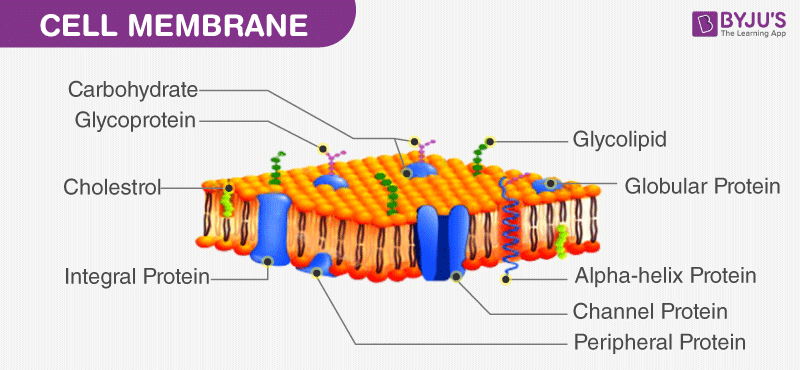Cell Membrane
- The cell membrane is an important component of all cells, regardless of whether or not they have a nucleus.
- Most cells are found floating in some sort of liquid. If they aren’t in an aqueous environment, they tend to dry out. So, the cell membrane surrounds the cell, protecting it from the external environment. The cell membrane ensures that the parts of the cell stay inside the cell and unwanted materials (including too much water) stay out of the cell. In addition, the cell membrane helps bring food, nutrients, and just enough water into the cell. It also helps remove waste from the cell.
- Even plant and prokaryotic cells having cell walls have a cell membrane inside the cell wall. If a cell does not have a cell wall, the cell membrane is also responsible for protecting the cell. It is strong enough to protect the cell from slight jostling and movements. It is not strong enough to keep the cell from bursting if it is hit hard or poked with a sharp object but will keep the cell intact during small collisions.
Structure
- The cell membrane is semi-permeable. If an object is permeable, everything can pass through it. A sieve, for example, is permeable. A cell membrane is not quite that permeable; it only allows certain things to pass through. It is considered semi-permeable.
- The cell membrane is made out of a phospholipid bilayer, which restricts movement in and out of the cell.
- Have you ever seen salad dressing separate? If you have, you’ve seen that the oil in the dressing does not mix with the water. This is because oil is hydrophobic. The root word hydro means “water” and the root word phobic means “scared” so molecules that are hydrophobic are literally “scared of water.” Oil is a lipid.
- The cell membrane is also made of lipids, which means the lipid part of the cell membrane does not like water. This keeps water out of the cell. If water were able to get into the cell and the cell couldn’t manage the influx of water, the organelles could dissolve and the cell could burst, which would be very problematic.
- Most substances can be dissolved by water. In fact, scientists often call water “the universal solvent” because it can dissolve so many things. But water cannot dissolve oil. The lipid part of the cell membrane keeps the cell from dissolving when in aqueous environments.
- The same properties of lipids that require us to shake our salad dressing before we use it, protect our cells from water in the outside environment.
Transport
- If the cell membrane is so protective, how do we get things in and out of the cell? Well, some very small molecules can fit through the phospholipids. Other larger molecules cannot fit in the spaces between the phospholipids, so these need another way into and out of the cell.
- The cell membrane has protein channels and pumps embedded in the membrane. The channels allow large molecules to enter and the pumps pull them into the cell.
- The cell membrane also has carbohydrates embedded in it. These carbohydrates act as ID cards. When cells bump into one another, they can identify each other and know if they are cells from the same organism or invader cells. An infection occurs when something gets into the cell that doesn’t belong within.
Surface Area to Volume Ratio
As cells grow, getting things in and out of the cell becomes more difficult. This is because the cell’s volume increases at a greater rate than its surface area. When this happens, the cell membrane becomes crowded with things that need to enter and leave the cell, causing a traffic jam of sorts. So, cells divide to avoid this problem and keep the cell from getting too large.
 Edited: 05 October 2022
Edited: 05 October 2022